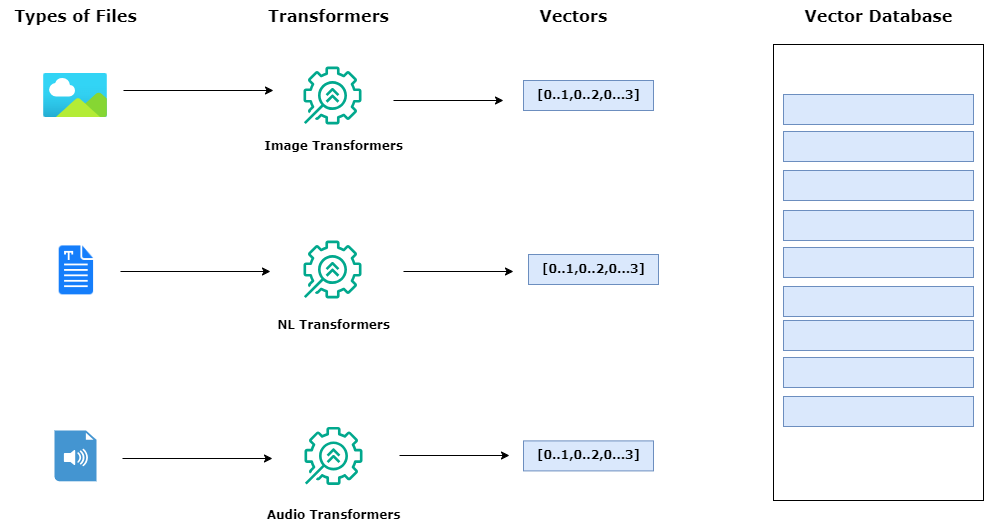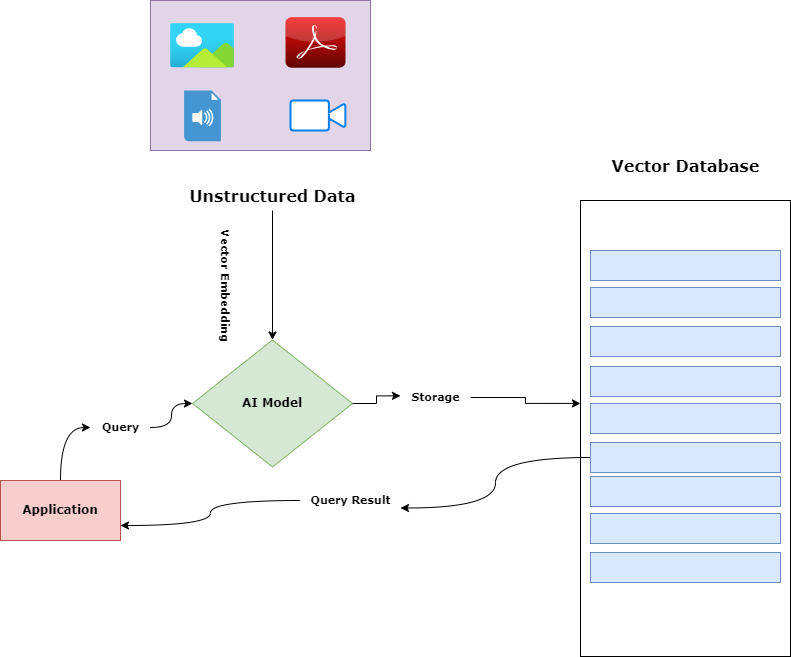In today’s data-driven world, artificial intelligence (AI) and machine learning (ML) require efficient data storage and retrieval methods. Enter Vector Databases—a breakthrough in how we handle large-scale, unstructured data, providing the backbone for smarter, faster AI models. Let’s dive into what vector databases are and why they’re essential in modern AI development.
Table of Contents
ToggleWhat is a Vector Database?

At its core, a vector database is a specialized type of database designed to store, manage, and search through high-dimensional data known as vectors. Vectors represent data points in numeric form, such as text, images, or videos. In AI, these vectors are used to encapsulate information in ways that allow for efficient similarity searches—making vector databases the preferred choice for AI models that rely on unstructured data.
Why Are Vector Databases Important for AI?
In traditional databases, data is typically stored in structured formats like tables and rows, making it difficult to manage unstructured data (e.g., images or free text). Vector databases revolutionize how AI models process this type of data, allowing for faster and more accurate responses.

The Rise of AI and Machine Learning
Evolution of Data Management in AI
As AI and machine learning models evolve, so does the need for more sophisticated data management systems. Traditional databases are often too slow or limited in scope for AI tasks like NLP, recommendation engines, or image recognition.
Challenges with Traditional Databases
Traditional relational databases excel at structured data processing but struggle with the speed and complexity required to manage high-dimensional data used by AI systems. They are not optimized for real-time searches or massive, unstructured datasets, which is where vector databases come into play.
How Does a Vector Database Work
The Concept of Vector Embeddings
In AI, data such as text or images are transformed into vector embeddings—a numerical representation of the data in high-dimensional space. These embeddings capture essential characteristics and relationships between data points, allowing for easy comparison through vector similarity search.
Vector Similarity Search
The core function of vector databases is vector similarity search, where the goal is to find data points (vectors) that are most similar to a given query vector. This process is crucial in applications like recommendation systems and AI-powered search engines.
Key Features of Vector Databases
High Performance for Unstructured Data
Vector databases are designed to process vast amounts of unstructured data in real time, making them invaluable for AI systems handling everything from images to voice recognition.
Scalability and Flexibility
Vector databases are scalable, meaning they can handle an increasing amount of data without compromising performance. They are also flexible, allowing users to store and retrieve data across various formats and domains.
Real-Time Data Processing
Unlike traditional systems, vector databases offer real-time data processing, ensuring faster and more accurate results, which is vital for applications like AI-powered search engines and recommendation systems.
Applications of Vector Databases
AI-Powered Search Engines
Vector databases enhance search engine functionality by improving the relevance of search results through semantic search techniques that understand user intent rather than relying solely on keyword matches.
Recommendation Systems
In platforms like e-commerce or streaming services, vector databases enable recommendation systems to suggest personalized content by comparing user behavior vectors with product or media vectors.
Natural Language Processing (NLP)
In NLP applications, vector databases are used to store and search for similarities between different pieces of text, allowing for more intuitive and human-like interactions with AI systems.
Image and Video Recognition
Vector databases are instrumental in image and video recognition, where they help AI models identify objects, faces, and other elements by analyzing vector embeddings of visual data.
Vector Databases vs. Traditional Databases
Handling Unstructured Data
Vector databases excel in handling unstructured data, making them far superior to traditional databases in AI applications.
Speed and Efficiency Comparison
The speed at which vector databases operate when searching through high-dimensional data is unmatched. This efficiency is critical for AI models that need to perform in real time.
AI Optimization
Because vector databases are built with AI in mind, they offer better optimization for machine learning pipelines compared to traditional databases.
Popular Vector Database Solutions
- Pinecone: Specializes in high-performance similarity search.
- Weaviate: An open-source, schema-less database optimized for unstructured data.
- Milvus: A highly scalable database built for AI and machine learning workloads.
Benefits of Using Vector Databases
Enhanced Search Accuracy
Vector databases enable more accurate search results, especially in applications requiring context or semantic understanding.
Improved AI Model Performance
By leveraging high-dimensional data, vector databases allow AI models to perform faster and with greater precision.
Efficient Data Retrieval
These databases provide efficient retrieval of relevant data, improving user experience and operational efficiency in AI applications.
Implementing Vector Databases in Your AI Workflow
Integration with Machine Learning Pipelines
Integrating a vector database into your machine learning pipeline can boost the performance of models by improving the speed of data access and analysis.
Best Practices for Implementation
When implementing vector databases, it’s essential to consider the size of the data, query complexity, and the intended AI application for optimal results.
Challenges in Vector Databases
Complexity in Setup and Management
While powerful, vector databases can be complex to set up and manage, often requiring specialized knowledge.
Cost Considerations
As with any advanced technology, costs can become a factor, particularly for organizations working with large datasets.
How to Choose the Right Vector Database
Key Factors to Consider
When selecting a vector database, consider factors like scalability, performance, and ease of integration with existing AI models.
Comparing Popular Solutions
Evaluate popular vector databases like Pinecone, Weaviate, and Milvus based on your organization’s specific needs and resources.
The Future of Vector Databases
Advancements in AI and Data Science
As AI and data science advance, vector databases will continue to play a pivotal role, driving innovation and transforming industries.
Emerging Trends
Emerging trends like federated learning and edge computing will likely increase the demand for vector databases in distributed AI systems.
Conclusion
Vector databases are a game-changer in AI, offering superior performance, scalability, and accuracy in handling unstructured data. As AI continues to evolve, vector databases will remain a critical tool for developers and data scientists, ensuring the development of smarter and faster AI models.
FAQs
- What Is the Difference Between Vector Databases and Traditional Databases? Vector databases specialize in storing and retrieving high-dimensional data, while traditional databases focus on structured data.
- Can Vector Databases Be Used Outside AI? Yes, vector databases are also useful in fields like recommendation engines, search, and even e-commerce.
- What Are Some Limitations of Vector Databases? Setup complexity and higher operational costs can be challenges when using vector databases.
- How Are Vector Databases Optimized for AI? Vector databases are designed to process and retrieve unstructured data, making them perfect for AI applications that rely on real-time data processing.
- What Industries Benefit the Most from Vector Databases? Industries like tech, healthcare, e-commerce, and entertainment benefit significantly from the speed and efficiency of vector databases.

